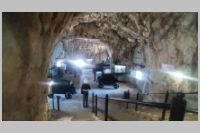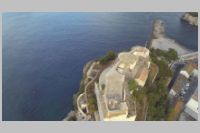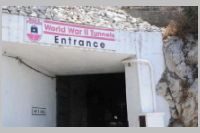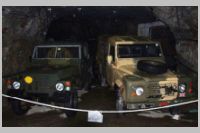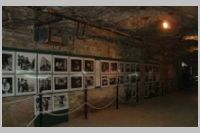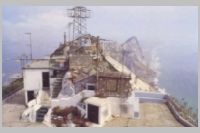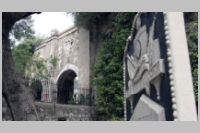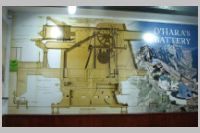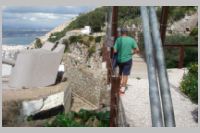The Defences of Gibraltar
The Defences of Gibraltar Introduction
- This is a very brief introduction into one of the most politically complex, most strategic locations, and most fought over locations in the World
- The Moors where the first rulers of Gibraltar to Erect defences.
- They were followed by the Spanish who improved the defences and also built the Southern King Charles V Wall.
- Then came The British who really went to town improving the exiting walls as cannon became more powerful. They also started the Great Siege Tunnels followed by the World War Tunnels, eventually having more miles of Tunnels inside The Rock than roads outside.
- There have been 14 Sieges of Gibraltar.
- 7 between the Moors & the Catholic forces, what we now call Spanish.
- 1 between rival Muslims
- 2 between rival Catholics
- 4 between Britain & Spain as follows.
- 11th 3 day Siege 1704. Britain Captured Gibraltar and has kept it ever since
- 12 th 7 month Siege 1704-1705 by Spain & France who abandoned the siege after no success.
- 13 th 5 month Siege 1727. Resulted in a signed truce which did not last very long.
- 14 th The Great Siege1779 until 1783.
Moorish Rule 711 - 1462
Moorish Castle & Walls 1160 after their conquest of Gibraltar in 711

Moorish Castle By Gibmetal77 - Own work, CC BY-SA 3.0
- The Moors ruled for 751 years. Easily the longest rulers of Gibraltar, seconded by the Brits. then lastly by the Spanish.
- The Moors Attacked Spain and landed in the region of Gibraltar in 711 and captured all of Spain in 8 years, except for the mountainous Basques territory in the north west
- Under the Almohad Sultan Abd al-Mu'min in the fortification of Gibraltar began after the Christian kings of Aragon and Castile began naval threats.
- They built the Moorish Castle and wall that travels up the side of the rock 1160 on the North edge of the town. This protected the town from attack from the North what we now call Spain.
- At this tine Spain was not yet a country
- They also built a wall on the Gibraltar Bay Sea Shore, in front of the town & south to Rosia Bay, the location is now inland after land reclamation. All of these sea walls have been rebuild by the Spanish and further fortified by the British that no Moorish remains can be seen.
- They did not build a wall protecting the South side of the town
Castilian & Spanish Rule 1462 - 1704
- The Spanish ruled for 242 years
- King Henry IV of Castile captured Gibraltar from the Moors.
- Spain did not become a country until 1492
Attack 1540
- In 1540 Corsairs from the Coast (ruled by Barbarossa a notorious pirate) landed at Europa Point Gibraltar in sixteen galleys They knew or found out that the town was unprotected from the South and they easily looted the town and took away many captive as hostages or slaves.
King Charles V Wall 1540
- After the attack by Barbary Pirates, King Charles V of Spain (1516 to 1556) had the wall built in 1540, as southern defences of the town
- King Charles V Wall extends from the South Bastion, then on the shoreline, going straight up he slope of The Rock.
Turning at 90 degrees to the right to run along the top of a shear section of the rock. Little is left of this section.
Then at the next 90 degrees turn, this time to the left continues on up the slope
This leg of the wall has 2 zig zags which allow for defensive fire along the face of the wall.
Ending at the top ridge of The Rock of Gibraltar by the Barbary Macaque Feeding Station. - A walkway runs along the top of the wall, with access by steps at most road intersections.
- There are Picnic areas along side the wall, with excellent views at Queens Road & Charles V Road
The British 1704 to the present day
The British 1704 to the present day
- The British ruled for over 280 years and still counting.
- with the aid of Dutch captured Gibraltar from the Spanish in 1704, during Spain's upheaval during the War of the Spanish Succession 1701-1714, created by the death of childless Charles II of Spain in 1700
- And Spain has tried to get it back ever since by war, diplomacy, & closing the border, which effects Gibraltar's economy and also reduces it's workforce because many Spanish work in Gibraltar & commute daily across the border. This in turn effects the Spanish's economy
The Great Siege of Gibraltar 1779 until 1783
- The Great Siege of Gibraltar lasted from 24 June 1779 to 7 February 1783
- It was Part of the American Revolutionary War.
- It was the British against Spain, France & to a lesser extent Hanover.
- It was the largest battle of the war with regards to numbers.
- The siege ended after negotiations. Britain ceded Florida Menorca to Spain Spain in exchange for Gibraltar and the Bahaman Islands
Great Siege Tunnels 1779 until 1783

Great Siege Tunnels Diarama Gunners preparing to fire downwards with a Cannon on a Koehler depressing Gun Carriage which elevates the rear of the muzzle
- The cannonball and powder were held in place using wadding to secure them within in the barrel of the cannon.
- Note the dangling rope in the gun port. this was there to help stop spafs & burning embers fromreentering the tunnel.
- Further preventions included hang wet cloth from the ceiling, not displayed, between the cannon and gunpowder charges storage.
- While Briton was busy fighting the of American War of Independence1775-1783 against America aided by France.
- Spain & France took this opportunity to attack Gibraltar starting The Great Siege July 1779 to February 1783
- The Brits. discovered during the siege, that. they had a blind spot in their Northern Defences that could be covered by placing a cannon on top of the Notch a spur promontory that juts out from the North East shear side of the rock during the siege.
- Originally the the Great Siege Tunnels were dug to aid in transporting cannon to the top of The Notch..
- The top of the notch, the proposed location for the cannon, is well below the top of the rock so sergeant-major Ince suggested that the only way of getting cannon there was to dig a tunnel.
- This idea was accepted & he was placed in charge of the project.
- To start with the tunnel was dug by hand tools but later explosives were used to speed up the work.
- The smoke & fumes caused by the explosions made it almost impossible to work so a side tunnel was dug and a hole made through the north face to vent the smoke.
- It was then realised what a perfect location to mount cannon, & a cannon was installed.
- This was called Windsor Gallery, followed by King's And Queen's Lines & after the siege ended St. George's Hall, and Cornwallis Chamber
- The original plan was scrapped and a series of side chambers were built as miners he headed towards the notch
- The most popular tourist attraction location, St. George's Hall, the very large hall was excavated inside the notch with position for 7 cannon located on the 3 outer sides of the notch spur. This achievement was completed after the siege had ended.
- Because the Great Siege Tunnels were high with the rock the cannon were fitted with Koehler depressing carriages this allowed the gunners to fire downwards. The cannon ball were wedged into the muzzles with wadding
Koehler depressing Gun Carriage
Video of Koehler depressing Gun Carriage firing
100 Ton Gun - The Largest Gun in the World
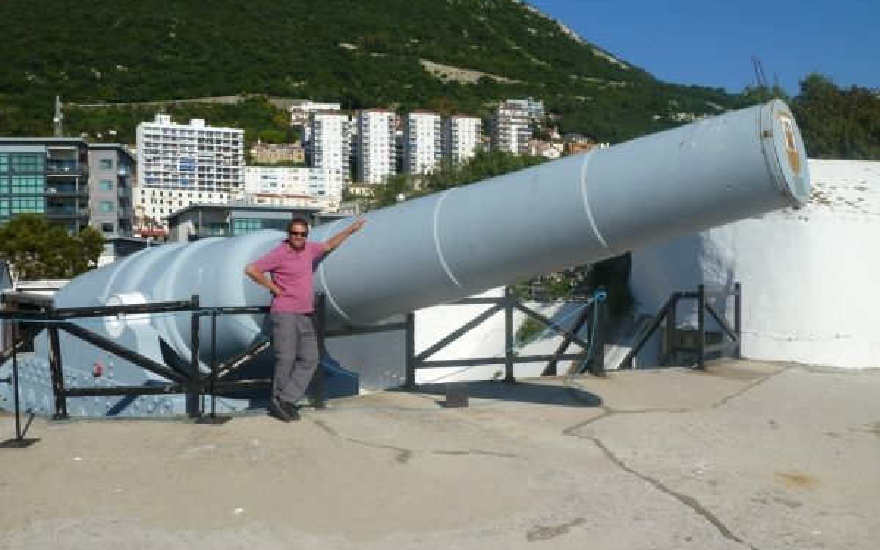
- The largest muzzle loading guns ever built.
- They were manufactured by Armstrong's of Newcastle.
- The British Admiralty were not interested in buying them until they heard that the Italian Navy had bought 8 for 2 of there battleships.
- The Royal Navy then rapidly bought 4, 2 for Gibraltar & 2 for Malta.
- Although loaded like a cannon they were not cannons but guns because they had riffled barrel and fired shells not balls.
- The guns at Gibraltar & Malta never fired a shot in anger.
- Because of rapid developments of gun technology the 100 Ton Guns were obsolete within 5 years
Gibraltar Town Ruined
- During The Great Siege Gibraltar Town was totally Destroyed and was rebuilt by The British.
- Gibraltar Town had City status granted by Queen Victoria in 1842
Parsons Lodge Battery 1875
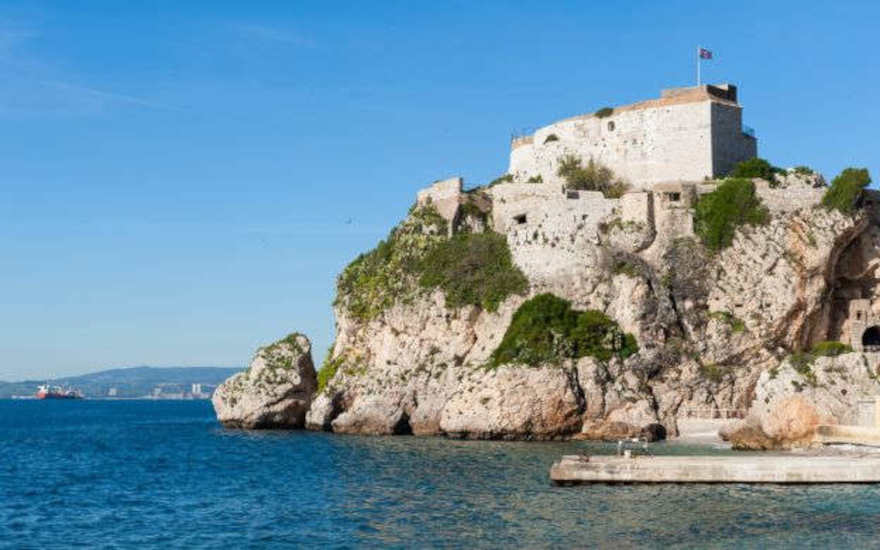
Parsons Lodge Battery
- As far as I know Parsons Lodge Battery is not open to the public but it is being renovated, so may be open in the future.
- It is however an impressive fortification and views of it can be seen from the 2 bays that are north & south of the fort.
- The fortress was built because the north bay Rosia Bay was the only natural harbour in Gibraltar. It was also the anchorage for Nelsons fleet and the location of the Royal Victualling Yard, the supply depot for the Royal Navy.
- The 2 bays to the south were ideal landing sites for an enemy.
- The tunnel beneath the Fortress and a second tunnel 580m further south the were only access point for vehicles along the West Coast, making Parsons Lodge Battery ideal defence positions.
Healy's Mortar 1771
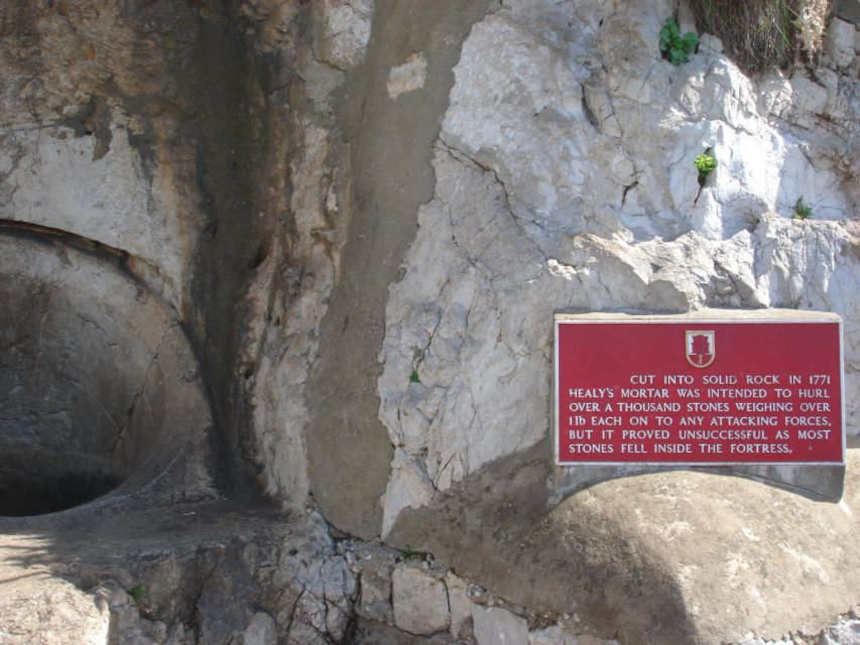
- Healy's Mortar was a large hole drilled into the rock. In the bottom of the hole was placed an explosive charge then covered over with a thousand rocks weighing over 1lb (0.454kg) each.
- The plaque on the site states When fired most rocks fell inside the fortress.
- Other accounts of the day says that The Governor & Colonel Boyd were quite pleased with its results.
- however the mortar was never used in anger
The British vs Germany & Italy WWII
World War II Tunnels
- There are more roads inside the rock tunnels than outside. The total length of all of the tunnel network inside the Rock is approximately 34 miles, 55 kilometres.
- Some Tunnels were large enough to allow lorries to drive along them. These included The Great North Road, Foss Way, Maida Vale, Powers Drive & Beefstock Magazine
- You have virtually a city built within the rock including an underground telephone exchange, a power generating station, a water distillation plant, a hospital, a bakery, ammunition magazines and a vehicle maintenance workshops
O’Hara’s Battery
- Built on the highest peak on The Rock
- Named after General Charles O'Hara, Governor of Gibraltar between 1795 and 1802
- 6-inch BL guns naval were installed in 1890.
- This was replaced by 9.2-inch guns with a range of 29,000 yards, 16 miles (26 km) in1901.
- In theory this gun and the other batteries in the area could fire onto Africa only 14 miles away. Therefore they could easily fire on enemy ships in the Straights of Gibraltar, this vital link between Mediterranean Sea & Atlantic Ocean
- See a video of this gun in action
See the British Army in action from having a game of cards in the bunker to running to the g un, wearing wwII uniforms & helmets, loading the gun then firing it in 1947
Click the full screen icon for a larger view
Princess Caroline's Battery / Military Heritage Centre
Military Heritage Centre
- It was constructed in 1732 and named after the third daughter of King George II. The battery saw action during the Great Siege of Gibraltar and required repairs. In 1871, the battery featured a 9-inch rifled muzzle loading gun, with an Elswick Ordnance Company carriage and platform. An Iron Cannon & Carriage is on display
- The battery was updated in 1905, and a 6 inch Mark VII gun was mounted above the magazine.
- In the Magazine see The Hoist & it's manually operated machinery to lift the shells to the Gun above the magazine
Haynes Cave Battery
- Located next to Windsor Suspension Bridge
Gibraltar: World War II and Fortress Highlights Tour
Visit the World War II tunnels, 100 Ton Gun, & O’Hara’s Battery. The imposing Moorish Castle, built by the Moors in 1160 AD after their conquest of Gibraltar in 711 AD
p Pickup includedThese are the pickup points: Gibraltar Midtown Coach parking, Gibraltar Frontier, Gibraltar Cruise Port and the City Center, Gibraltar (Casemates Square).


